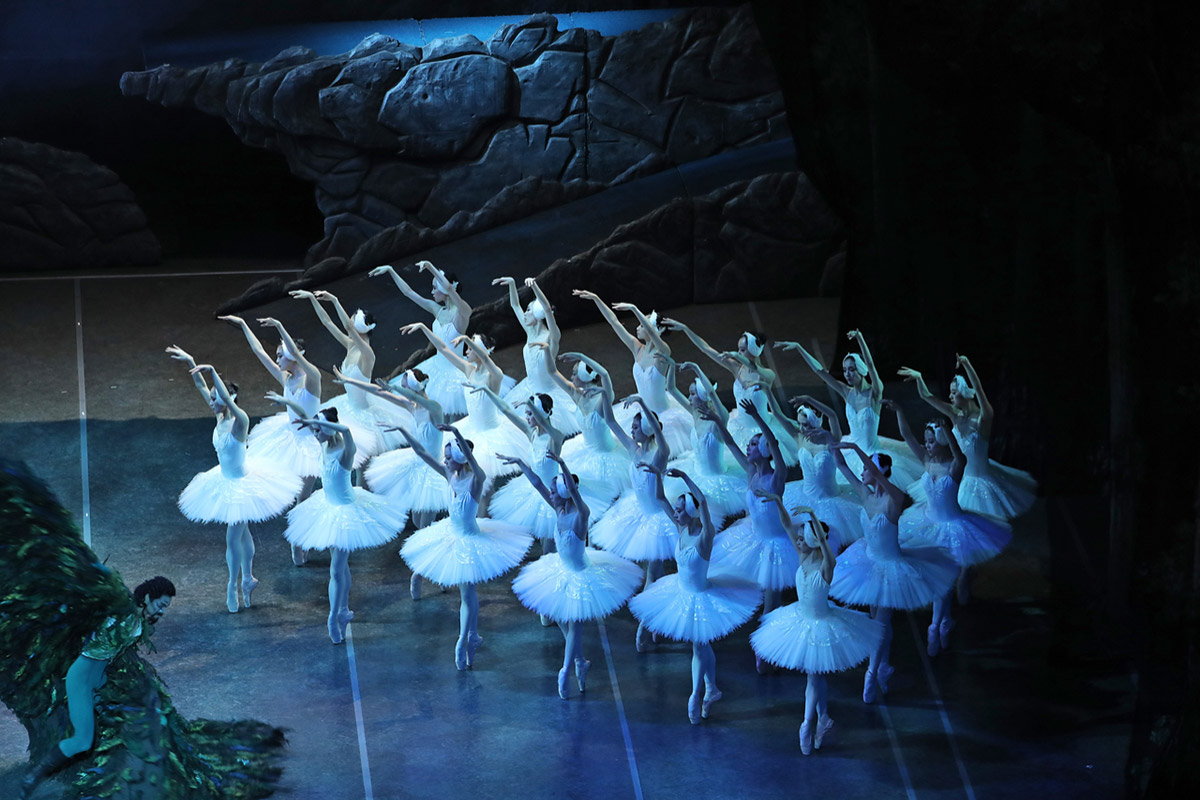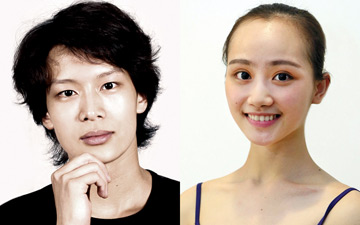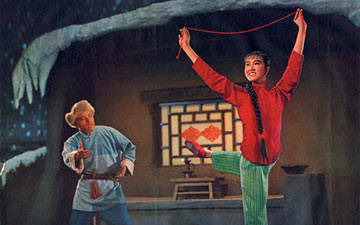
© North America Photography Association. (Click image for larger version)
Shanghai Ballet
Swan Lake
★★★★✰
New York, David H. Koch Theater
17 January 2020
www.shanghaiballet.com
davidhkochtheater.com
Towards the end of Swan Lake’s first act, it’s become almost de rigueur for Siegfried to perform what I’ve come to think of as the sad-arabesque solo, an adagio in which, through slow outside pirouettes melting into a deep fourth, or slow renverses, or anything involving slowness and arabesques, he expresses his dismay at his impending marriage and longing for something better (or Benno), crossbow optional. As Petipa never made such (that I know of, certainly there was none in ABT’s canonical David Blair staging), these have been added by succeeding generations of choreographers, and, even when they’re different, they’re the same, and usually a tiresome pitstop on the road to Odette.
I’d expected more of the same from Derek Deane’s version of said solo, coming at the end of a dramatically sparse first act, as Shanghai Ballet gave his production of the ballet at Lincoln Center recently. Reduced to little more than a zippy suite of dances, this act had given the evening’s Siegfried, Wu Husheng, little chance for characterization, other than a generic bit of moping when informed by his mother of his bachelorhood’s imminent demise. As he began that solo, I admired Wu’s beautiful technique, the religious scrupulousness of his preparations and carriage, and the delicacy of his dramatic shadings. Then, like a bolt through the heart, I felt something of the pain of his character’s yearning, and my vision grew misty. I’ve seen versions of this solo for decades, some quite affecting, but I’ve never felt anything close to the emotional wallop Wu delivered. It’s comforting to know that at even my advanced age I can still be confounded even by hoary old Swan Lake.
Imagine Siegfried as the Poet from Les Sylphides, his billowing arms tracing the ineffable, the plastic curve of his torso and delicately angled epaulement seemed imbued with nostalgia and regret. While Wu’s occasional forays into subdued mime, as when he’d finish a diagonal by taking a halting step downstage while reaching softly toward a corner, were effective, it was through his pure and gorgeous phrasing he spoke most eloquently. While the above-mentioned outside pirouette is almost a cliché, I was transfixed with Wu’s turns, his arms rising high in fifth, then drooping to his sides as he finished in that deep fourth, falling like reluctant rose petals. Then, his perfectly quartered promenades in arabesque made me think of searching around the compass for the escape he knows he won’t find. I can’t praise Wu enough; he slayed with understatement.
I’d say that Wu was the cherry on this particular performance’s sundae, but that would be neglecting the Shanghai Ballet’s superb corps, strong and with unity of step and style. As swans (48!), they’re a monumental white organism, less ostentatious in their perfection than certain Russian and French companies I might mention, and all the better for it. Their national dances had the speed and precision of drill teams, fun ones. Wu’s Odette/Odile, Qi Bingxue, was beautiful, short of torso and with long and supple limbs, yet seemed dramatically distant from Wu. More on these in a bit.
For the performances at the Koch Theater, American Ballet Theatre’s Charles Barker led the New York City Ballet Orchestra with welcome alacrity. This was one of the fastest Swan Lakes I can recall; in particular, we were in and out of the first and third acts in the blink of an eye, it seemed, and who could object to that?
Deane’s Swan Lake is much the one he staged in the round for the English National Ballet, except, well, not in-the-round. Deprived of that novelty, this is a solid, blessedly old-fashioned staging, with some oddities perhaps artifacts of the production’s original milieu, and some unfortunate conceits. As mentioned, Charles Barker and the NYCB Orchestra kept things moving along swimmingly, and, for the most part, Peter Farmer’s designs and costumes were effective, traditional and unobtrusive.
The production began with a prologue showing Odette captured and transformed into a swan, here by the profoundly hammy Rothbart of Zhou Haibo. While such prologues might be helpful to audiences unfamiliar with Swan Lake, they destroy the effect of Odette’s Act II entrance, one of the most celebrated in ballet, because we’ve already seen her as a swan. In Deane’s production, she also bourrees into the wings, arms flapping, also spoiling the effect of Odette’s Act II exit, also one of the most celebrated, etc.
Although the program describes Rothbart as half-man, half-bird, Zhou’s costume had him flapping about “wings” which looked for all the world like sheets of moulting green Astroturf. I wondered if Zhou’s cartoonish makeup and affect represented more of an Eastern tradition than usual in this ballet, as he spent much time after capturing Odette walking the edge of the orchestra pit, waving his “wings” and leering out at the audience, perhaps in search of bad little children who don’t brush their teeth he could abduct and transform into still more swans (they have to come from somewhere). Long before the end of the ballet I found myself wishing for my own crossbow to dispatch this nuisance.

© North America Photography Association. (Click image for larger version)
There are no extraneous courtiers, extra peasants, maypoles, goblets, or toasts in the spare first act (although we do get the slapstick tutor); in fact, Siegfried seems to have been invited to a suite of dances thrown in his honor. And what dances! The dance for the “nobles” flew by, with the corps showing off its speed and precision for the first of many times. My attention was piqued when a woman ran on and announced the approaching Queen with the traditional mime for a crown, prettily tapping the heel of her hand twice against her brow. My attention was even more piqued at the Pas de Trois, danced by Meng Fanyu, Zhou Jiawen, and Yu Qiaoer with strength and amplitude; these are all generous dancers. After Siegfried received the sad news (and crossbow) from his mother, the first-act peasants lined up for their polonaise, which I’d never before thought of as a tour de force, but, wow. The last time I saw a great corps de ballet showing off like this was back in 2012, with the Paris Opera Ballet’s slightly overwrought Giselle. As the peasant couples chasèed one at a time into the wings, I was almost giddy with admiration.
After Wu’s aforementioned heart-wrenching sad-arabesque solo, I was hooked, and looked forward to the lakeside scene. In what appeared to be an artifact of Deane’s original in-the-round staging, Odette didn’t leap in from the wings, but emerged from a small scrum of swans, much like Esther Williams arising from a Hollywood fountain. On a regular proscenium stage, it seemed melodramatic, as did the intrusive presence of the maniacally flapping Rothbart. Qi Bingxue’s Odette was exquisite — with longish arms and legs and a relatively short torso, she limned Odette’s passages into lovely, rippling calligraphy. Was she the lead principal dancer because her back arched more deeply, and her arms curved more luxuriantly than her swan-maiden cohorts, or the converse? While Qi and Wu looked gorgeous together — they’ve been the Shanghai Ballet’s leading couple for a few years now — I didn’t feel much emotional connection between the two. Their beautifully performed White Swan pas didn’t approach the affective punch of Wu’s first-act solo, to my disappointment. Qi wore her Knitted Brow of Concern (which one sees in certain Russian ballerinas) like a fixèd mask of soulful dismay. Would that her Odette’s persona matched her own gutsy dancing, and that of the kick-ass, all-for-one, etc., corps de ballet. They were always a thrill, whether making lace traceries as the stars’ living backdrop, or breaking across the stage in perfect waves of traveling arabesques as the scene rushed to its climax. They didn’t sell themselves — they didn’t need to — but got down to their business of perfection with an endearing modesty. The act was filled with wonders, like the four little swans polished and graceful, the diagonal of sometimes-problematic pas de chats as light as a feather. They were succeeded, in Deane’s staging, by, not two Big Swans, but four, because why not?
And again there was Rothbart, who, after summoning his swans and setting the wondrous ballet blanc in motion, crouched downstage center, waving about his enormous ratty wings, or Astroturf blanket, or whatever it was, obstructing, for far too long, our view of the ranks of magical swan maidens audiences pay good money to see; it’s not called Rothbart for a reason. Worst was at the act’s end, as Qi enacted quite movingly Odette’s transformation back to a swan, arms becoming wings while she bourreed towards the wings (never mind that we’d seen it before), facing upstage, Rothbart got all up in her face, flapping his own wings in time with her arms, pacing her offstage. I imagine this was supposed to look as if Rothbart were impelling her change, like a puppeteer with a marionette, but he looked more like a demented shadow or those crazy guys you pretend not to see on the subway. Another iconic moment ruined; hooray!

© North America Photography Association. (Click image for larger version)
Barker and the City Ballet orchestra continued to keep things moving briskly along in a third act which, like the first, was more a suite of dances, which was fine with me. After Siegfried’s tortured indecision over the waltz of the princesses, it was off to the races with the national dances, which were every bit as exciting as the first-act peasants and nobles hinted they’d be. Like Kevin McKenzie with his production for ABT, Deane retains the familiar czardas and mazurka from ABT’s old Blair production; it was like seeing old friends. Really ripped and buff old friends. The express-train Mazurka left me breathless.
The Black Swan pas de deux was about as you’d expect, with an especially intrusive Rothbart. Wu was excellent (I’m running out of adjectives), although flagged a little in the coda. Qi’s Odile was more engaged with Wu as they the adagio’s various seductions, although she was most vivid in impersonating Odette’s swanny bourrees, an enthusiastic deception. Qi’s line was a thing of joy, and I loved her clear, juicy musicality in Odile’s long solo, and even her twenty-seven fouettés (not that I was counting), which drifted languidly downstage with a hook to house right at the finish.

© North America Photography Association. (Click image for larger version)
The big treat of the fourth act was another look at that stupendous, no-nonsense corps surfing the monster waves of Tchaikovsky’s crescendos. Qi and Wu made their moving farewells, then simply ran into the wings, ignoring the big upstage cliff which had been awaiting them upstage like a gallows (or so I thought). It gave Zhou’s Rothbart a fine over-the-top platform for his over-the-top death (finally!). I welcomed the apotheosis, with Odette and Siegfried rising to the heavens in Farmer’s gloriously old-school swan boat, because that’s how the ballet should end, dammit. Should every Swan Lake be such a thrill ride? I wouldn’t mind.

















I am enchanted to read another of Eric Taub’s specific reviews and share his enthusiasm for the Chinese dancers. Beyond the presences of Yuan Yuan Tan,
a Shanghai product, in San Francisco, the Chinese dancers who have competed at Jackson the last decade or so have been extraordinary as well. I would swear there is something about exposure to classical Asian calligraphy which contributes to their
special qualities. And it takes someone like Eric to discern it. Write more, Eric..
Loved the “Knitted Brow of Concern” bit! I enjoyed reading your review as much as ever, Eric – more would be very welcome, if you feel so inclined.